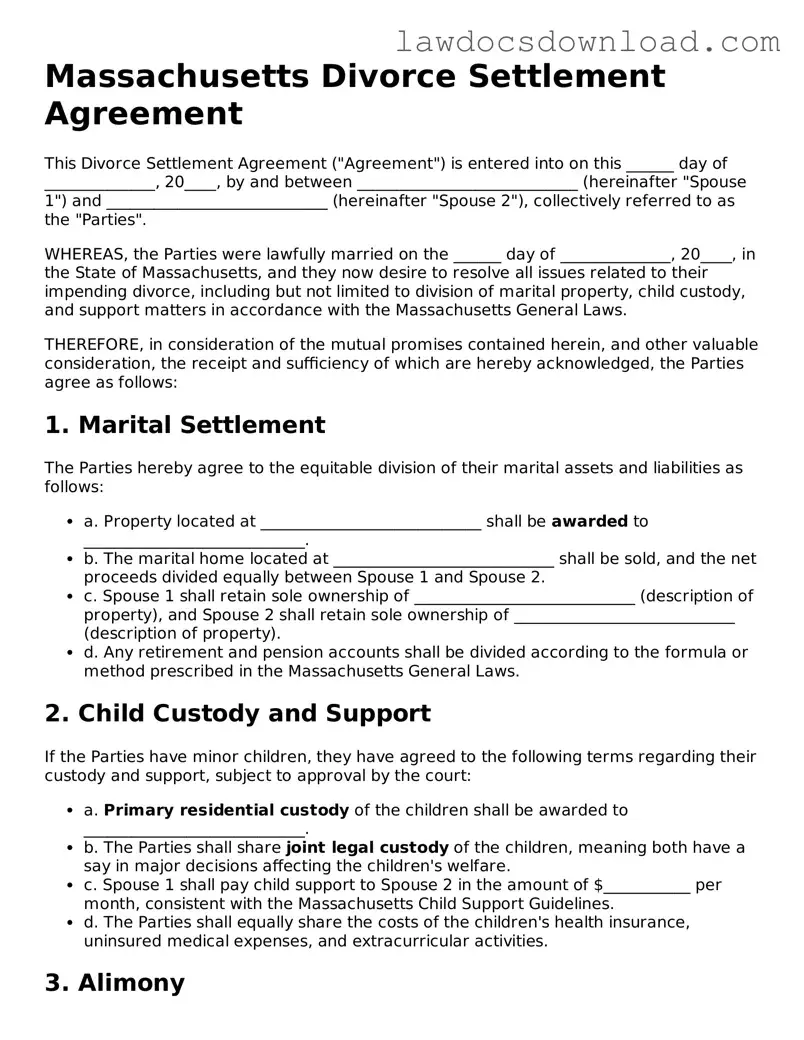Massachusetts Divorce Settlement Agreement
This Divorce Settlement Agreement ("Agreement") is entered into on this ______ day of ______________, 20____, by and between ____________________________ (hereinafter "Spouse 1") and ____________________________ (hereinafter "Spouse 2"), collectively referred to as the "Parties".
WHEREAS, the Parties were lawfully married on the ______ day of ______________, 20____, in the State of Massachusetts, and they now desire to resolve all issues related to their impending divorce, including but not limited to division of marital property, child custody, and support matters in accordance with the Massachusetts General Laws.
THEREFORE, in consideration of the mutual promises contained herein, and other valuable consideration, the receipt and sufficiency of which are hereby acknowledged, the Parties agree as follows:
1. Marital Settlement
The Parties hereby agree to the equitable division of their marital assets and liabilities as follows:
- a. Property located at ____________________________ shall be awarded to ____________________________.
- b. The marital home located at ____________________________ shall be sold, and the net proceeds divided equally between Spouse 1 and Spouse 2.
- c. Spouse 1 shall retain sole ownership of ____________________________ (description of property), and Spouse 2 shall retain sole ownership of ____________________________ (description of property).
- d. Any retirement and pension accounts shall be divided according to the formula or method prescribed in the Massachusetts General Laws.
2. Child Custody and Support
If the Parties have minor children, they have agreed to the following terms regarding their custody and support, subject to approval by the court:
- a. Primary residential custody of the children shall be awarded to ____________________________.
- b. The Parties shall share joint legal custody of the children, meaning both have a say in major decisions affecting the children's welfare.
- c. Spouse 1 shall pay child support to Spouse 2 in the amount of $___________ per month, consistent with the Massachusetts Child Support Guidelines.
- d. The Parties shall equally share the costs of the children's health insurance, uninsured medical expenses, and extracurricular activities.
3. Alimony
___[Spouse 1/Spouse 2]___ (the "Paying Spouse") shall pay to ___[Spouse 1/Spouse 2]___ (the "Receiving Spouse") the sum of $___________ per month as alimony for a period of ______ years, consistent with Massachusetts General Laws regarding spousal support.
4. Entire Agreement
This Agreement constitutes the entire agreement between the Parties concerning the subject matter hereof and supersedes all prior agreements and understandings, both written and oral, among the Parties with respect to that subject matter.
5. Governing Law
This Agreement shall be governed by and construed in accordance with the laws of the State of Massachusetts, without regard to its conflict of laws principles.
6. Execution
IN WITNESS WHEREOF, the Parties have executed this Agreement as of the date first above written.
_____________________________
Spouse 1 Signature
_____________________________
Spouse 2 Signature
